Impact of the Novaya Zemlya Bora on the Ocean-Atmosphere Heat Exchange and Ocean Circulation: A Case-Study with the Coupled Model
Abstract
:1. Introduction
2. Materials and Methods
2.1. COAWST Model
2.2. Atmospheric Model
2.3. Ocean Model
2.4. Sea Waves Model
2.5. Experimental Design
3. Results
3.1. Description of the Bora Eipsode and Model Verification
3.2. Impact of Model Coupling on Turbulent Fluxes
3.3. Impact of Bora on Turbulent Fluxes and Ocean Processes
4. Discussion and Conclusions
- When the interaction between the atmosphere and sea waves is taken into account, turbulent heat exchange increases (on average by 3%) due to an increase in the roughness coefficient near the coast (up to 100–150 km from the coast) caused by young steep waves.
- When the interaction of the atmosphere and the ocean is taken into account, the turbulent heat exchange averaged over the region does not change compared to the control experiment. SST cooling was found only in a narrow strip near the coast, while the difference in SST between the control and “AO” experiments is multidirectional elsewhere. This could be due to complexity of processes determining water temperature, such as heat advection with currents, heat release and consumption of sea ice freezing/melting.
- When both ocean and wave models are coupled with the atmospheric model, the above effects of ocean and sea waves add up and we see two zones where (1) fluxes increase due to rough waves on a distance of up to 100 km from the shore and (2) the effect of coupling on fluxes is generally small in the open sea. In this fully coupled run, the effect of decreased heat fluxes due ocean cooling near the coast is overwhelmed by the greater increase of roughness (and turbulent fluxes, consequently) due to sea waves.
- Bora reduces the turbulent heat exchange between the ocean and the atmosphere (compared to similar conditions in the absence of bora) by 18% on average over the region, although in the coastal region, heat transfer locally increases by 50–150%.
- Bora intensifies ocean current along the western coast of Novaya Zemlya by 0.1–0.25 m s−1 on average
- Orography of NZ and orographic winds conserve heat in the ocean. The average ocean heat content in this region decreased by 2.7% during bora, but it decreased even more in the flat experiment
- Since the direct influence of bora winds extends only to the coastal zone, bora does not directly affect the mixing of the Atlantic water, since it flows too far from the coast.
- Salinization (due to increased evaporation and formation of new ice during bora) and, to a lesser extent, cooling of coastal waters leads to a strong water densification. In the flat experiment, this densification is weakened, and the water density is noticeably lower than the density of the Arctic Intermediate Water. Thus, bora clearly contributes to the formation of dense waters on the NZ shelf, and accounting for bora is necessary for a correct assessment of this process. Water densification was also revealed during the Adriatic bora [68]; however, only the effect of model coupling, but not the bora itself, on densification has been considered. Summarizing, when modeling the ocean and sea ice to study the formation of bottom waters near Novaya Zemlya with coarse-resolution atmospheric forcing (as, for example, in [69]) one should be careful about the resulting estimates.
Author Contributions
Funding
Institutional Review Board Statement
Informed Consent Statement
Data Availability Statement
Acknowledgments
Conflicts of Interest
References
- Giorgi, F.; Gao, X.J. Regional earth system modeling: Review and future directions. Atmos. Ocean. Sci. Lett. 2018, 11, 189–197. [Google Scholar] [CrossRef] [Green Version]
- Aldrian, E.; Sein, D.; Jacob, D.; Gates, L.D.; Podzun, R. Modelling Indonesian rainfall with a coupled regional model. Clim. Dyn. 2005, 25, 1–17. [Google Scholar] [CrossRef]
- Wei, J.; Malanotte-Rizzoli, P.; Eltahir, E.A.B.; Xue, P.; Xu, D. Coupling of a regional atmospheric model (RegCM3) and a regional ocean model (FVCOM) over the maritime continent. Clim. Dyn. 2014, 43, 1575–1594. [Google Scholar] [CrossRef] [Green Version]
- Holt, T.; Cummings, J.A.; Bishop, C.H.; Doyle, J.D.; Hong, X.; Chen, S.; Jin, Y. Development and testing of a coupled ocean–atmosphere mesoscale ensemble prediction system. Ocean Dyn. 2011, 61, 1937–1954. [Google Scholar] [CrossRef]
- Ricchi, A.; Miglietta, M.M.; Falco, P.P.; Benetazzo, A.; Bonaldo, D.; Bergamasco, A.; Sclavo, M.; Carniel, S. On the use of a coupled ocean–atmosphere–wave model during an extreme cold air outbreak over the Adriatic Sea. Atmos. Res. 2016, 172, 48–65. [Google Scholar] [CrossRef]
- Sitz, L.E.; Di Sante, F.; Farneti, R.; Fuentes-Franco, R.; Coppola, E.; Mariotti, L.; Reale, M.; Sannino, G.; Barreiro, M.; Nogherotto, R.; et al. Description and evaluation of the Earth System Regional Climate Model (Reg CM-ES). J. Adv. Model. Earth Syst. 2017, 9, 1863–1886. [Google Scholar] [CrossRef]
- Kumar, P.; Mishra, A.K.; Dubey, A.K.; Javed, A.; Saharwardi, M.; Kumari, A.; Sachan, D.; Cabos, W.; Jacob, D.; Sein, D.V. Regional earth system modelling framework for CORDEX-SA: An integrated model assessment for Indian summer monsoon rainfall. Clim. Dyn. 2022, 1–20. [Google Scholar] [CrossRef]
- Bruneau, N.; Toumi, R. A fully-coupled atmosphere-ocean-wave model of the Caspian Sea. Ocean Model. 2016, 107, 97–111. [Google Scholar] [CrossRef]
- Di Sante, F. Assessing the role of local air–sea interaction over the South Asia region in simulating the Indian Summer Monsoon (ISM) using the new earth system model RegCM-ES. In Proceedings of the 19th EGU General Assembly, Vienna, Austria, 23–28 April 2017; p. 2562. [Google Scholar]
- Zou, L.W.; Zhou, T.J. Can a regional ocean–atmosphere coupled model improve the simulation of the interannual variability of the western north pacific summer monsoon? J. Clim. 2013, 26, 2353–2367. [Google Scholar] [CrossRef]
- Van Pham, T.; Brauch, J.; Dieterich, C.; Frueh, B.; Ahrens, B. New coupled atmosphere-ocean-ice system COSMO-CLM/NEMO: Assessing air temperature sensitivity over the North and Baltic Seas. Oceanologia 2014, 56, 167–189. [Google Scholar] [CrossRef] [Green Version]
- Kelemen, F.D.; Primo, C.; Feldmann, H.; Ahrens, B. Added value of atmosphere-ocean coupling in a century-long regional climate simulation. Atmosphere 2019, 10, 537. [Google Scholar] [CrossRef] [Green Version]
- Pellerin, P.; Ritchie, H.; Saucier, F.J.; Roy, F.; Desjardins, S.; Valin, M.; Lee, V. Impact of a two-way coupling between an atmospheric and an ocean-ice model over the Gulf of St. Lawrence. Mon. Weather Rev. 2004, 132, 1379–1398. [Google Scholar] [CrossRef]
- Ren, S.; Liang, X.; Sun, Q.; Yu, H.; Tremblay, L.B.; Lin, B.; Mai, X.; Zhao, F.; Li, M.; Liu, N.; et al. A fully coupled Arctic sea-ice–ocean–atmosphere model (ArcIOAM v1. 0) based on C-Coupler2: Model description and preliminary results. Geosci. Model Dev. 2021, 14, 1101–1124. [Google Scholar] [CrossRef]
- Smith, G.C.; Bélanger, J.M.; Roy, F.; Pellerin, P.; Ritchie, H.; Onu, K.; Roch, M.; Zadra, A.; Colan, D.S.; Winter, B.; et al. Impact of coupling with an ice–ocean model on global medium-range NWP forecast skill. Mon. Weather Rev. 2018, 146, 1157–1180. [Google Scholar] [CrossRef]
- Janssen, P.A.E.M.; Breivik, O.; Mogensen, K.; Vitart, F.; Balmaseda, M.; Bidlot, J.-R.; Keeley, S.; Leutbecher, M.; Magnusson, L.; Molteni, F. Air–sea interaction and surface waves. In ECMWF Tech Memorandum 712; ECMWF: Reading, UK, 2013; 34p. [Google Scholar]
- Brassington, G.B.; Martin, M.J.; Tolman, H.L.; Akella, S.; Balmeseda, M.; Chambers, C.R.S.; Chassignet, E.; Cummings, J.A.; Drillet, Y.; Janssen, P.A.E.M.; et al. Progress and challenges in short-to medium-range coupled prediction. J. Oper. Oceanogr. 2015, 8, s239–s258. [Google Scholar] [CrossRef]
- Kim, H.-S.; Lozano, C.; Tallapragada, V.; Iredell, D.; Sheinin, D.; Tolman, H.L.; Gerald, V.M.; Sims, J. Performance of ocean simulations in the coupled HWRF–HYCOM model. J. Atmos. Ocean Tech. 2014, 31, 545–559. [Google Scholar] [CrossRef]
- Liu, N.; Ling, T.; Wang, H.; Zhang, Y.; Gao, Z.; Wang, Y. Numerical simulation of Typhoon Muifa (2011) using a coupled ocean-atmosphere-wave-sediment transport (COAWST) modeling system. J. Ocean Univ. China 2015, 14, 199–209. [Google Scholar] [CrossRef]
- Mogensen, K.S.; Magnusson, L.; Bidlot, J.R. Tropical cyclone sensitivity to ocean coupling in the E CMWF coupled model. J. Geophys. Res. Oceans 2017, 122, 4392–4412. [Google Scholar] [CrossRef]
- Wu, L. Effect of atmosphere-wave-ocean/ice interactions on a polar low simulation over the Barents Sea. Atmos. Res. 2021, 248, 105183. [Google Scholar] [CrossRef]
- Ribeiro, F.N.D.; Soares, J.; de Oliveira, A.P. A coupled numerical model to investigate the air-sea interaction at the coastal upwelling area of Cabo Frio, Brazil. Environ. Fluid Mech. 2011, 11, 651–668. [Google Scholar] [CrossRef]
- Li, H.; Kanamitsu, M.; Hong, S.Y.; Yoshimura, K.; Cayan, D.R.; Misra, V. A high-resolution ocean-atmosphere coupled downscaling of the present climate over California. Clim. Dyn. 2014, 42, 701–714. [Google Scholar] [CrossRef]
- Lee, C.M.; Askari, F.; Book, J.; Carniel, S.; Cushman-Roisin, B.; Dorman, C.; Doyle, J.; Flament, P.; Harris, C.K.; Jones, B.H.; et al. Northern Adriatic response to a wintertime bora wind event. Eos Trans. Am. Geophys. Union 2005, 86, 157–165. [Google Scholar] [CrossRef] [Green Version]
- Thompson, B.; Sanchez, C.; Sun, X.; Song, G.; Liu, J.; Huang, X.Y.; Tkalich, P. A high-resolution atmosphere–ocean coupled model for the western Maritime Continent: Development and preliminary assessment. Clim. Dyn. 2018, 52, 3951–3981. [Google Scholar] [CrossRef]
- Ricchi, A.; Miglietta, M.M.; Barbariol, F.; Benetazzo, A.; Bergamasco, A.; Bonaldo, D.; Cassardo, C.; Falcieri, F.M.; Modugno, G.; Russo, A.; et al. Sensitivity of a Mediterranean tropical-like cyclone to different model configurations and coupling strategies. Atmosphere 2017, 8, 92. [Google Scholar] [CrossRef] [Green Version]
- Mishra, A.K.; Kumar, P.; Dubey, A.K.; Jha, S.K.; Sein, D.V.; Cabos, W. Demonstrating the asymmetry of the Indian Ocean Dipole response in regional earth system model of CORDEX-SA. Atmos. Res. 2022, 273, 106182. [Google Scholar] [CrossRef]
- Loglisci, N.; Qian, M.W.; Rachev, N.; Cassardo, C.; Longhetto, A.; Purini, R.; Trivero, P.; Ferrarese, S.; Giraud, C. Development of an atmosphere-ocean coupled model and its application over the Adriatic Sea during a severe weather event of Bora wind. J. Geophys. Res. Atmos. 2004, 109, D01102. [Google Scholar] [CrossRef]
- Ličer, M.; Smerkol, P.; Fettich, A.; Ravdas, M.; Papapostolou, A.; Mantziafou, A.; Strajnar, B.; Cedilnik, J.; Jeromel, M.; Jerman, J.; et al. Modeling the ocean and atmosphere during an extreme bora event in northern Adriatic using one-way and two-way atmosphere–ocean coupling. Ocean Sci. 2016, 12, 71–86. [Google Scholar] [CrossRef] [Green Version]
- Martin, R.; Moore, G.W.K. Air-sea interaction associated with a Greenland reverse tip jet. Geophys. Res. Lett. 2007, 34, L24802. [Google Scholar] [CrossRef]
- Vize, V.Y. The Novaya Zemlya bora. Izv. Tsentr. Gidrometeorol. Byuro 1925, 5, 1–55. (In Russian) [Google Scholar]
- Bryazgin, N.N.; Dementiev, A.A. Hazardous Meteorological Phenomena in the Russian Arctic; Gidrometeoizdat: Sankt-Petersburg, Russia, 1996; p. 150. [Google Scholar]
- Shestakova, A.A.; Toropov, P.A.; Matveeva, T.A. Climatology of extreme downslope windstorms in the Russian Arctic. Weather Clim. Extrem. 2020, 28, 100256. [Google Scholar] [CrossRef]
- Martin, S.; Cavalieri, D.J. Contributions of the Siberian shelf polynyas to the Arctic Ocean intermediate and deep water. J. Geophys. Res. Oceans 1989, 94, 12725–12738. [Google Scholar] [CrossRef]
- Myslenkov, S.; Shestakova, A.; Chechin, D. The impact of sea waves on turbulent heat fluxes in the Barents Sea according to numerical modeling. Atmos. Chem. Phys. 2021, 21, 5575–5595. [Google Scholar] [CrossRef]
- Moore, G.W.K. The Novaya Zemlya Bora and its impact on Barents Sea air-sea interaction. Geophys. Res. Lett. 2013, 40, 3462–3467. [Google Scholar] [CrossRef] [Green Version]
- Warner, J.C.; Armstrong, B.; He, R.; Zambon, J.B. Development of a Coupled Ocean-Atmosphere-Wave-Sediment Transport (COAWST) modeling system. Ocean Model. 2010, 35, 230–244. [Google Scholar] [CrossRef] [Green Version]
- The Model Coupling Toolkit. Available online: http://www.mcs.anl.gov/research/projects/mct/ (accessed on 14 June 2022).
- Taylor, P.K.; Yelland, M.J. The dependence of sea surface roughness on the height and steepness of the waves. J. Phys. Oceanogr. 2001, 31, 572–590. [Google Scholar] [CrossRef] [Green Version]
- Oost, W.A.; Komen, G.J.; Jacobs, C.M.J.; Van Oort, C. New evidence for a relation between wind stress and wave age from measurements during ASGAMAGE. Bound. Layer Meteorol. 2002, 103, 409–438. [Google Scholar] [CrossRef]
- Drennan, W.; Graber, H.; Hauser, D.; Quentin, C. On the wave age dependence of wind stress over pure wind seas. J. Geophys. Res. Oceans 2003, 108, 8062. [Google Scholar] [CrossRef]
- Budgell, W. Numerical simulation of ice-ocean variability in the Barents sea region. Ocean Dynam. 2005, 55, 370–387. [Google Scholar] [CrossRef]
- Mellor, G.L.; Kantha, L. An ice-ocean coupled model. J. Geophys. Res. Oceans 1989, 94, 10937–10954. [Google Scholar] [CrossRef]
- Hunke, E.C. Viscous-Plastic sea ice dynamics with the EVP model: Linearization issues. J. Comput. Phys. 2001, 170, 18–38. [Google Scholar] [CrossRef]
- Hunke, E.C.; Dukowicz, J.K. An elastic-viscous-plastic model for sea ice dynamics. J. Phys. Oceanogr. 1997, 27, 1849–1867. [Google Scholar] [CrossRef] [Green Version]
- Kumar, R.; Li, J.; Hedstrom, K.; Babanin, A.V.; Holland, D.M.; Heil, P.; Tang, Y. Intercomparison of Arctic sea ice simulation in ROMS-CICE and ROMS-Budgell. Polar Sci. 2021, 29, 100716. [Google Scholar] [CrossRef]
- Skamarock, W.C.; Klemp, J.B.; Dudhia, J.; Gill, D.O.; Barker, D.M.; Wang, W.; Powers, J.G. A Description of the Advanced Research WRF Version 2; NCAR Technical Note; University Corporation for Atmospheric Research: Boulder, CO, USA, 2005. [Google Scholar] [CrossRef]
- Sukoriansky, S.; Galperin, B.; Staroselsky, I. A quasinormal scale elimination model of turbulent flows with stable stratification. Phys. Fluids 2005, 17, 085107. [Google Scholar] [CrossRef]
- Shestakova, A.A. Impact of land surface roughness on downslope windstorm modelling in the Arctic. Dyn. Atmos. Oceans 2021, 95, 101244. [Google Scholar] [CrossRef]
- Hong, S.Y.; Lim, J.O.J. The WRF single-moment 6-class microphysics scheme (WSM6). Asia-Pac. J. Atmos. Sci. 2006, 42, 129–151. [Google Scholar]
- Iacono, M.J.; Delamere, J.S.; Mlawer, E.J.; Shephard, M.W.; Clough, S.A.; Collins, W.D. Radiative forcing by long–lived greenhouse gases: Calculations with the AER radiative transfer models. J. Geophys. Res. 2008, 113, D13103. [Google Scholar] [CrossRef]
- Tewari, M.; Chen, F.; Wang, W.; Dudhia, J.; LeMone, M.A.; Mitchell, K.; Ek, M.; Gayno, G.; Wegiel, J.; Cuenca, R.H. Implementation and verification of the unified NOAH land surface model in the WRF model (Formerly Paper Number 17.5). In Proceedings of the 20th Conference on Weather Analysis and Forecasting/16th Conference on Numerical Weather Prediction, Seattle, WA, USA, 12–16 January 2004; Volume 14. [Google Scholar]
- Regional Ocean Modeling System (ROMS). Available online: https://www.myroms.org/ (accessed on 17 June 2022).
- SODA Ocean Reanalysis. Available online: https://www.soda.umd.edu/ (accessed on 20 June 2022).
- Egbert, G.D.; Erofeeva, S.Y. Efficient inverse modeling of barotropic ocean tides. J. Atmos. Ocean. Technol. 2002, 19, 183–204. [Google Scholar] [CrossRef] [Green Version]
- Mellor, G.L.; Yamada, T. Development of a turbulence closure model for geophysical fluid problems. Rev. Geophys. 1982, 20, 851–875. [Google Scholar] [CrossRef] [Green Version]
- Chapman, D.C. Numerical treatment of cross-shelf open boundaries in a barotropic coastal ocean model. J. Phys. Oceanogr. 1985, 15, 1060–1075. [Google Scholar] [CrossRef] [Green Version]
- Marchesiello, P.; McWilliams, J.C.; Shchepetkin, A. Open boundary conditions for long-term integration of regional oceanic models. Ocean Model. 2001, 3, 1–20. [Google Scholar] [CrossRef]
- Flather, R.A. A tidal model of the northwest European continental shelf. Mem. Soc. Roy. Sci. Liege Ser. 1976, 6, 141–164. [Google Scholar]
- Komen, G.J.; Hasselmann, S.; Hasselmann, K. On the existence of a fully developed wind-sea spectrum. J. Phys. Oceanogr. 1984, 14, 1271–1285. [Google Scholar] [CrossRef]
- Hasselmann, K.; Barnett, T.P.; Bouws, E.; Carlson, H.; Cartwright, D.E.; Enke, K.; Ewing, J.A.; Gienapp, H.; Hasselmann, D.E.; Kruseman, P.; et al. Measurements of wind−wave growth and swell decay during the Joint North Sea Wave Project (JONSWAP). In Ergaenzungsheft zur Deutschen Hydrographischen Zeitschrift, Hamburg, Reihe A(8); Deutsches Hydrographisches Institut: Hamburg, Germany, 1973; Volume 12, p. 95. [Google Scholar]
- Janssen, P.A. Wave-induced stress and the drag of air flow over sea waves. J. Phys. Oceanogr. 1989, 19, 745–754. [Google Scholar] [CrossRef] [Green Version]
- Janssen, P.A. Quasi-linear theory of wind-wave generation applied to wave forecasting. J. Phys. Oceanogr. 1991, 21, 1631–1642. [Google Scholar] [CrossRef] [Green Version]
- Charnock, H. Wind stress on a water surface. Q. J. Roy. Meteor. Soc. 1955, 81, 639–640. [Google Scholar] [CrossRef]
- Davis, C.; Wang, W.; Chen, S.S.; Chen, Y.; Corbosiero, K.; DeMaria, M.; Dudhia, J.; Holland, G.; Klemp, J.; Michalakes, J.; et al. Prediction of landfall hurricanes with the advanced hurricane WRF model. Mon. Weather Rev. 2008, 136, 1990–2005. [Google Scholar] [CrossRef] [Green Version]
- Shestakova, A.A.; Myslenkov, S.A.; Kuznetsova, A.M. Influence of Novaya Zemlya Bora on sea waves: Satellite measurements and numerical modeling. Atmosphere 2020, 11, 726. [Google Scholar] [CrossRef]
- Buzin, I.V.; Glazovskij, A.F. Icebergs of the Shokalsky Glacier, Novaya Zemlya. Mater. Glyaciologicheskih Issled. 2005, 99, 39–44. [Google Scholar]
- Carniel, S.; Benetazzo, A.; Bonaldo, D.; Falcieri, F.M.; Miglietta, M.M.; Ricchi, A.; Sclavo, M. Scratching beneath the surface while coupling atmosphere, ocean and waves: Analysis of a dense water formation event. Ocean Model. 2016, 101, 101–112. [Google Scholar] [CrossRef]
- Årthun, M.; Ingvaldsen, R.B.; Smedsrud, L.H.; Schrum, C. Dense water formation and circulation in the Barents Sea. Deep Sea Res. Part I Oceanogr. Res. Pap. 2011, 58, 801–817. [Google Scholar] [CrossRef] [Green Version]
- Shestakova, A.A.; Chechin, D.G.; Lüpkes, C.; Hartmann, J.; Maturilli, M. The foehn effect during easterly flow over Svalbard. Atmos. Chem. Phys. 2022, 22, 1529–1548. [Google Scholar] [CrossRef]
- Repina, I.A.; Artamonov, A.Y.; Varentsov, M.I.; Kozyrev, A.V. Experimental study of the sea surface wind drag coefficient at strong winds. Morsk. Gidrofiz. Zhurnal 2015, 1, 53–63. (In Russian) [Google Scholar]
- Vickers, D.; Mahrt, L.; Sun, J.; Crawford, T. Structure of offshore flow. Mon. Weather Rev. 2001, 129, 1251–1258. [Google Scholar] [CrossRef]
- Gutjahr, O.; Heinemann, G. A model-based comparison of extreme winds in the Arctic and around Greenland. Int. J. Climatol. 2018, 38, 5272–5292. [Google Scholar] [CrossRef] [Green Version]
- Hughes, M.; Cassano, J.J. The climatological distribution of extreme Arctic winds and implications for ocean and sea ice processes. J. Geophys. Res. Atmos. 2015, 120, 7358–7377. [Google Scholar] [CrossRef]
- NCEP/DOE Reanalysis 2 (R2). Research Data Archive at the National Center for Atmospheric Research, Computational and Information Systems Laboratory; University Corporation for Atmospheric Research (UCAR): Boulder, CO, USA, 2020. [CrossRef]
- European Centre for Medium-Range Weather Forecasts. ERA-Interim Project. Research Data Archive at the National Center for Atmospheric Research, Computational and Information Systems Laboratory; University Corporation for Atmospheric Research (UCAR): Boulder, CO, USA, 2009. [Google Scholar] [CrossRef]
- Saha, S. NCEP Climate Forecast System Reanalysis (CFSR) 6-Hourly Products, January 1979 to December 2010; Research Data Archive at the National Center for Atmospheric Research; Computational and Information Systems Laboratory: Boulder, CO, USA, 2010. [Google Scholar] [CrossRef]
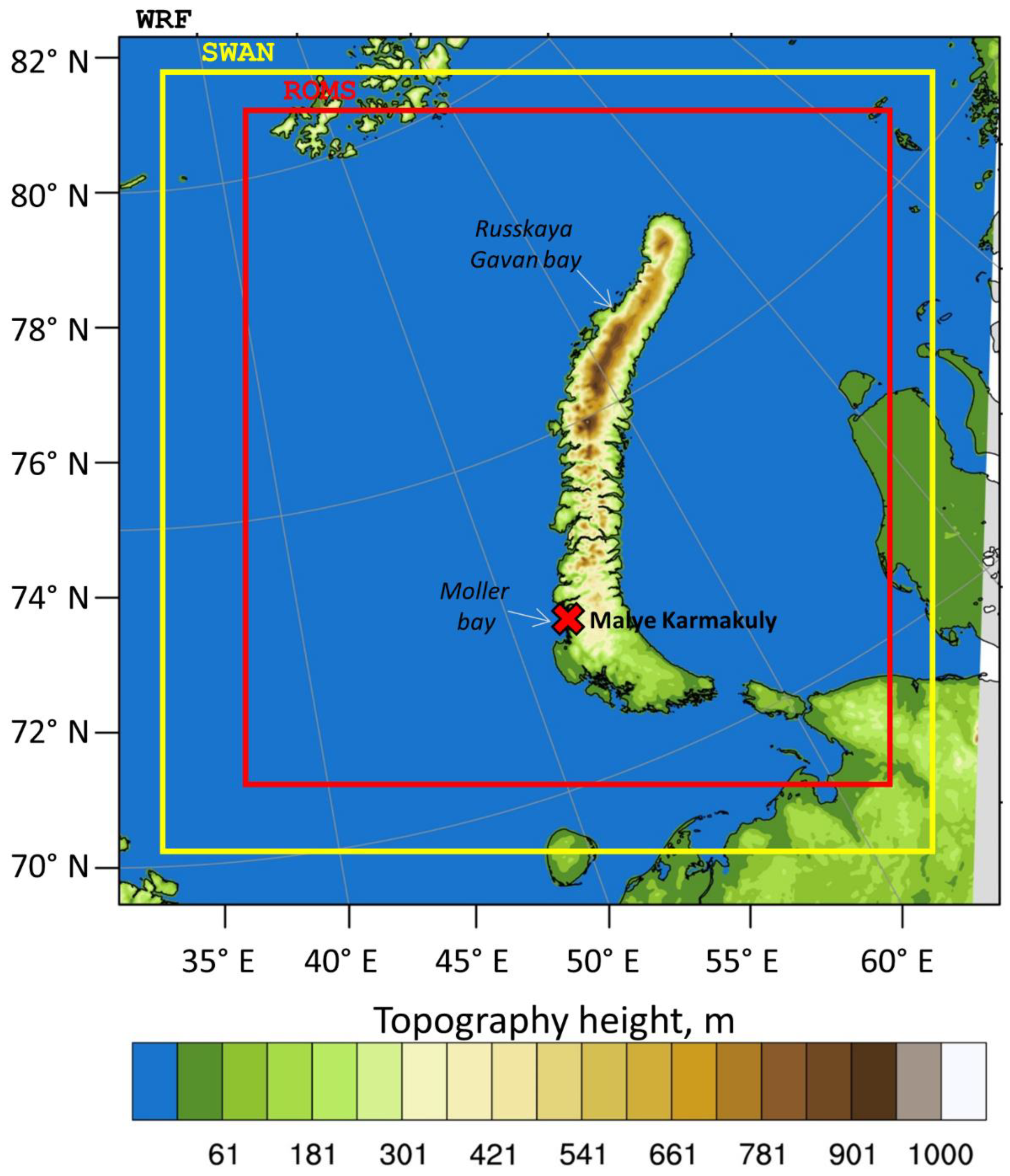

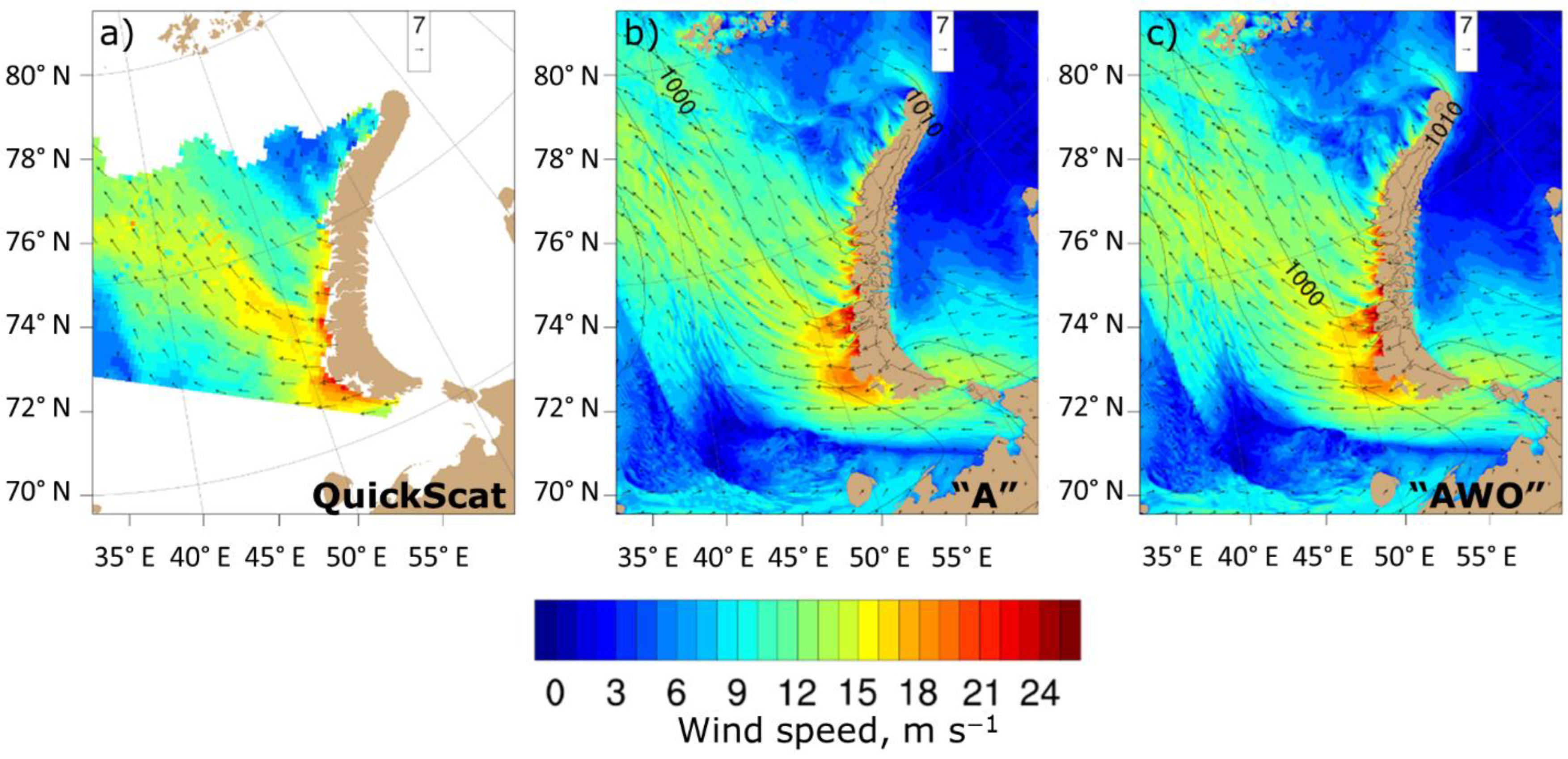
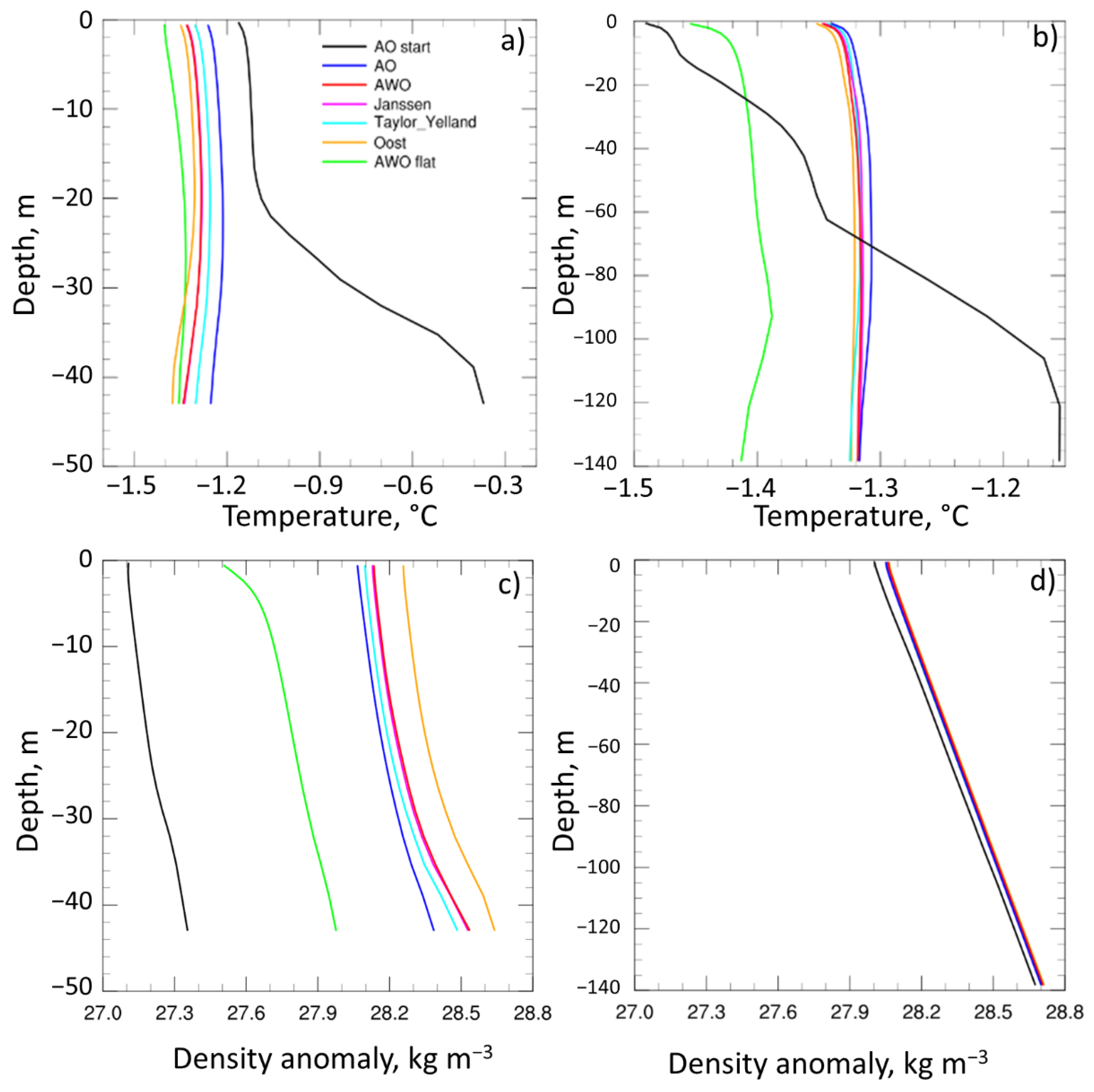
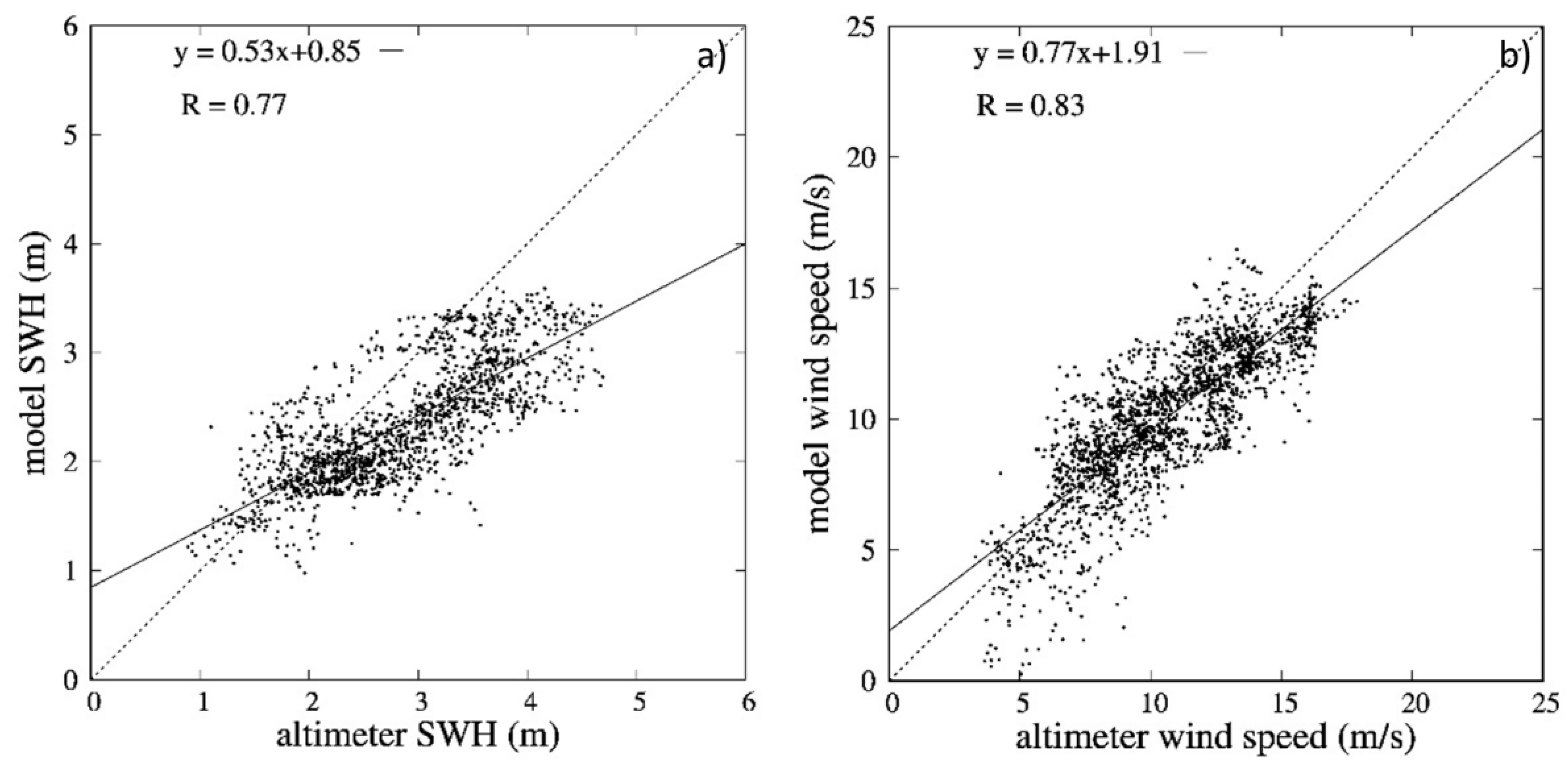
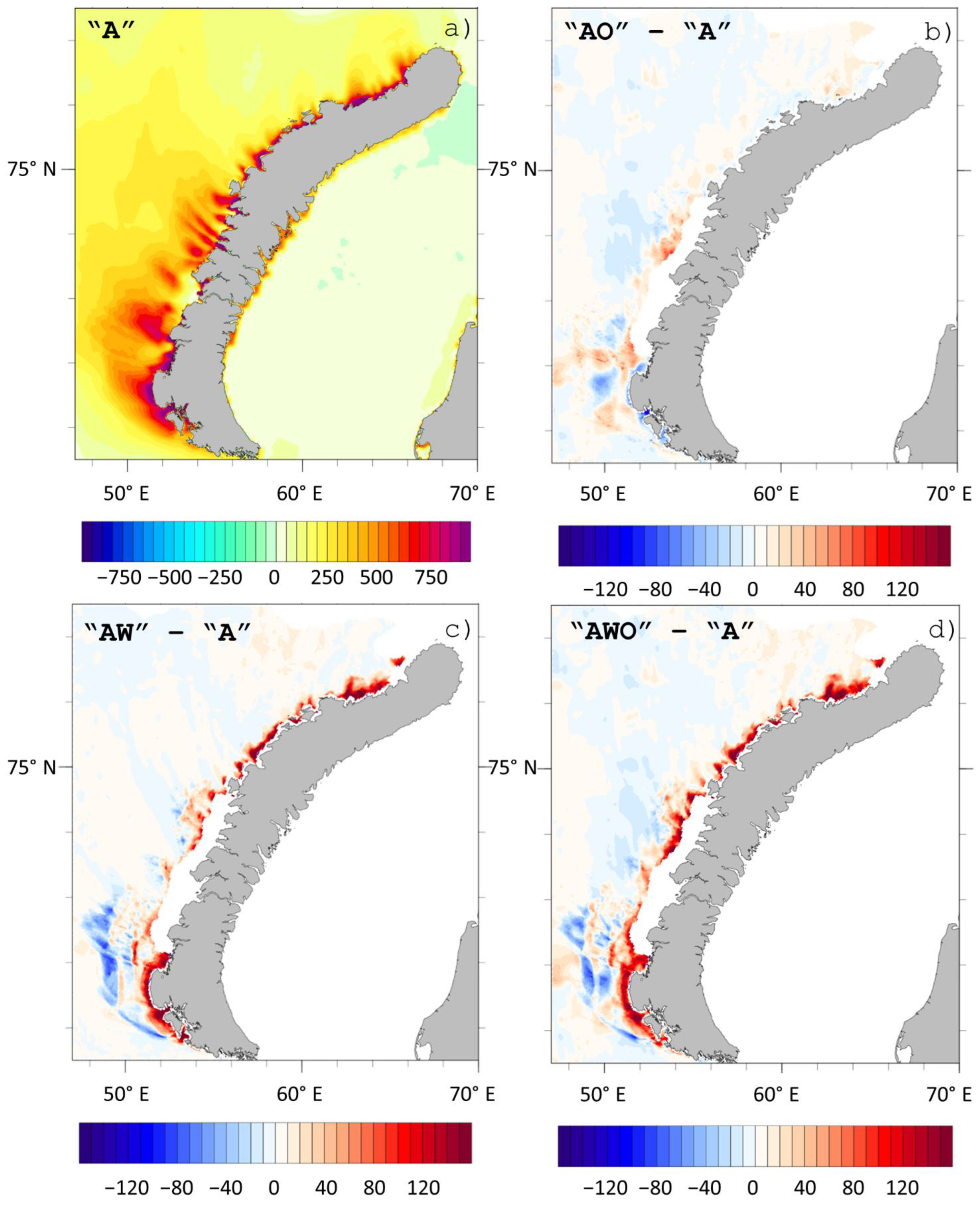
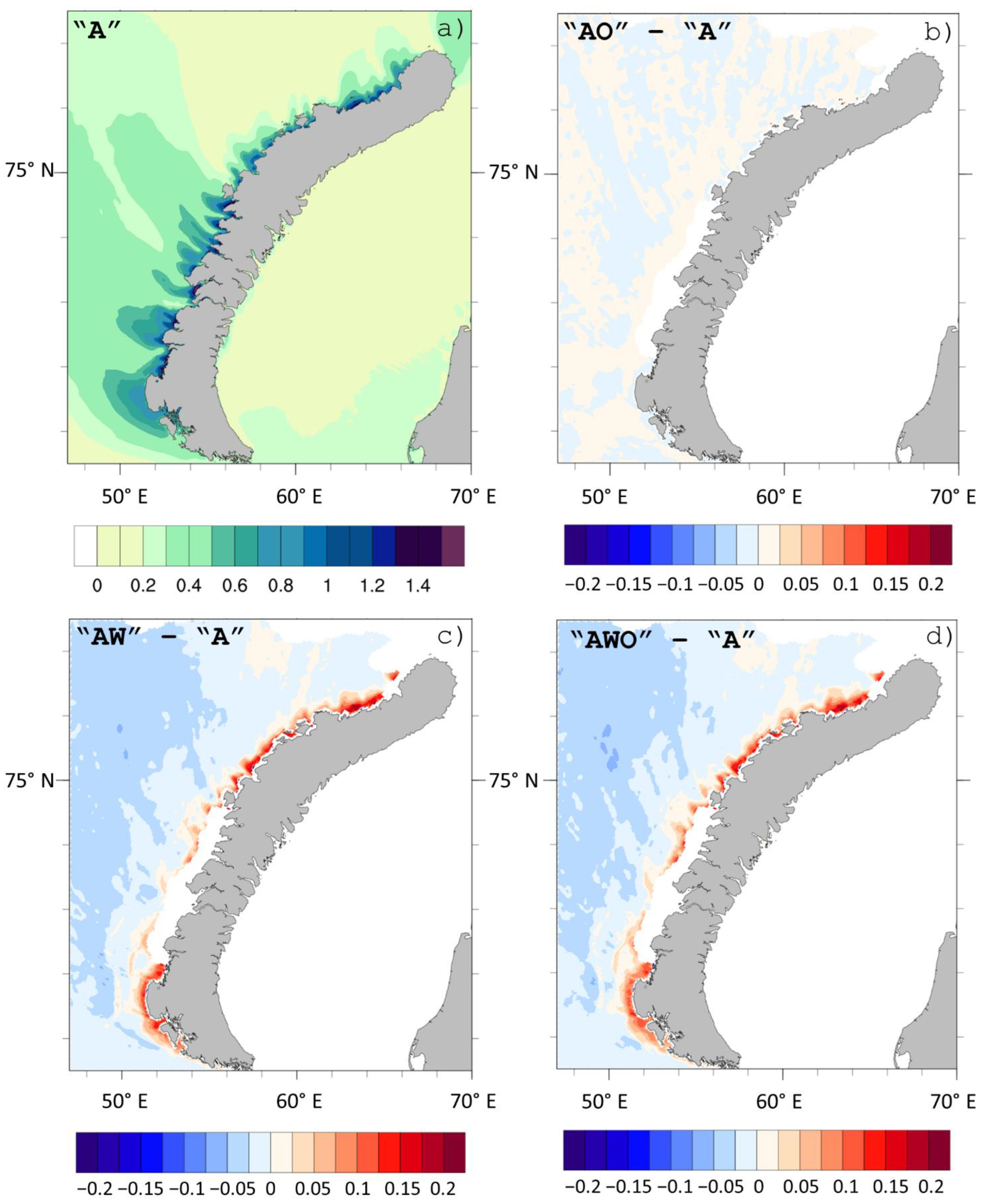
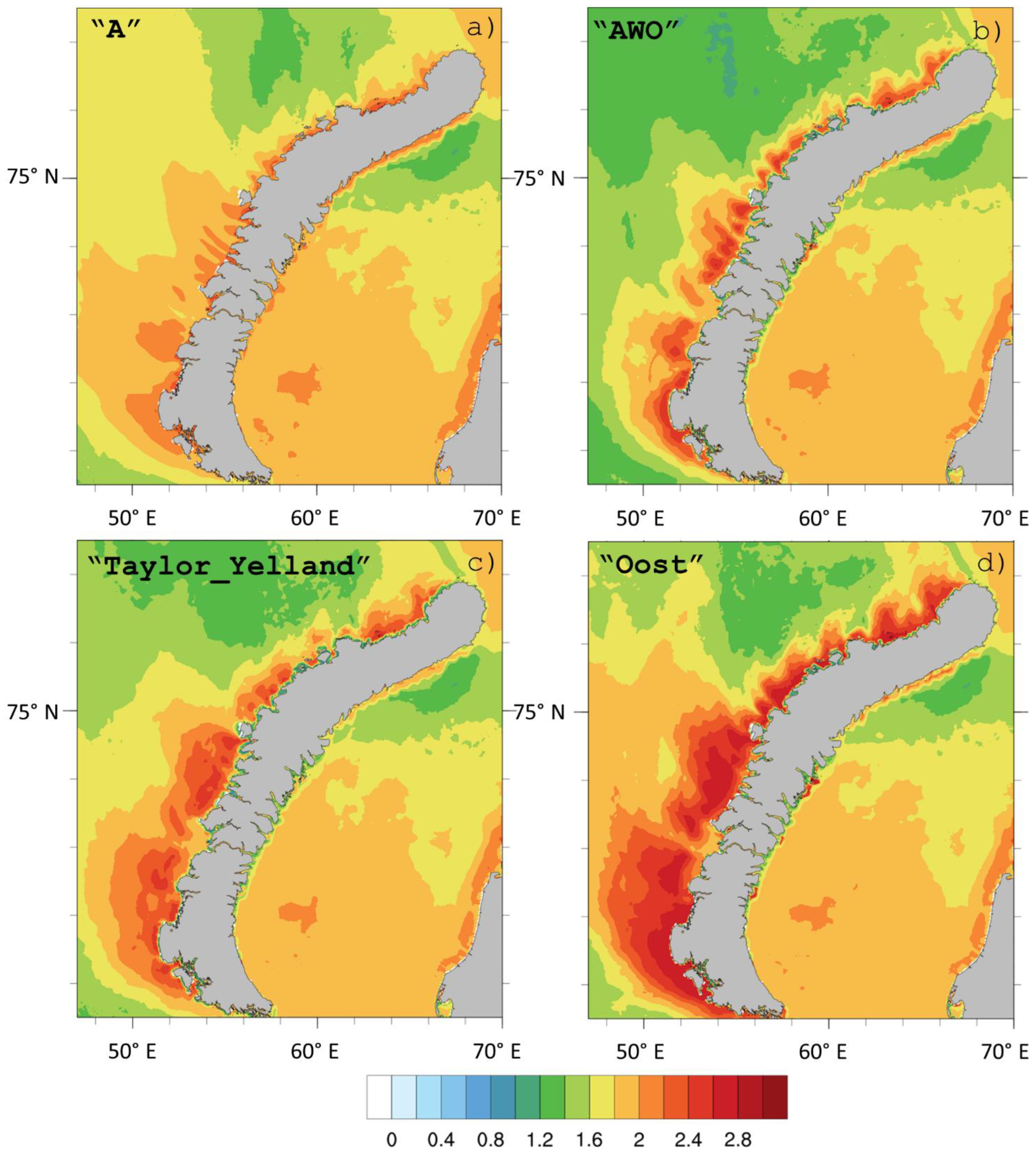
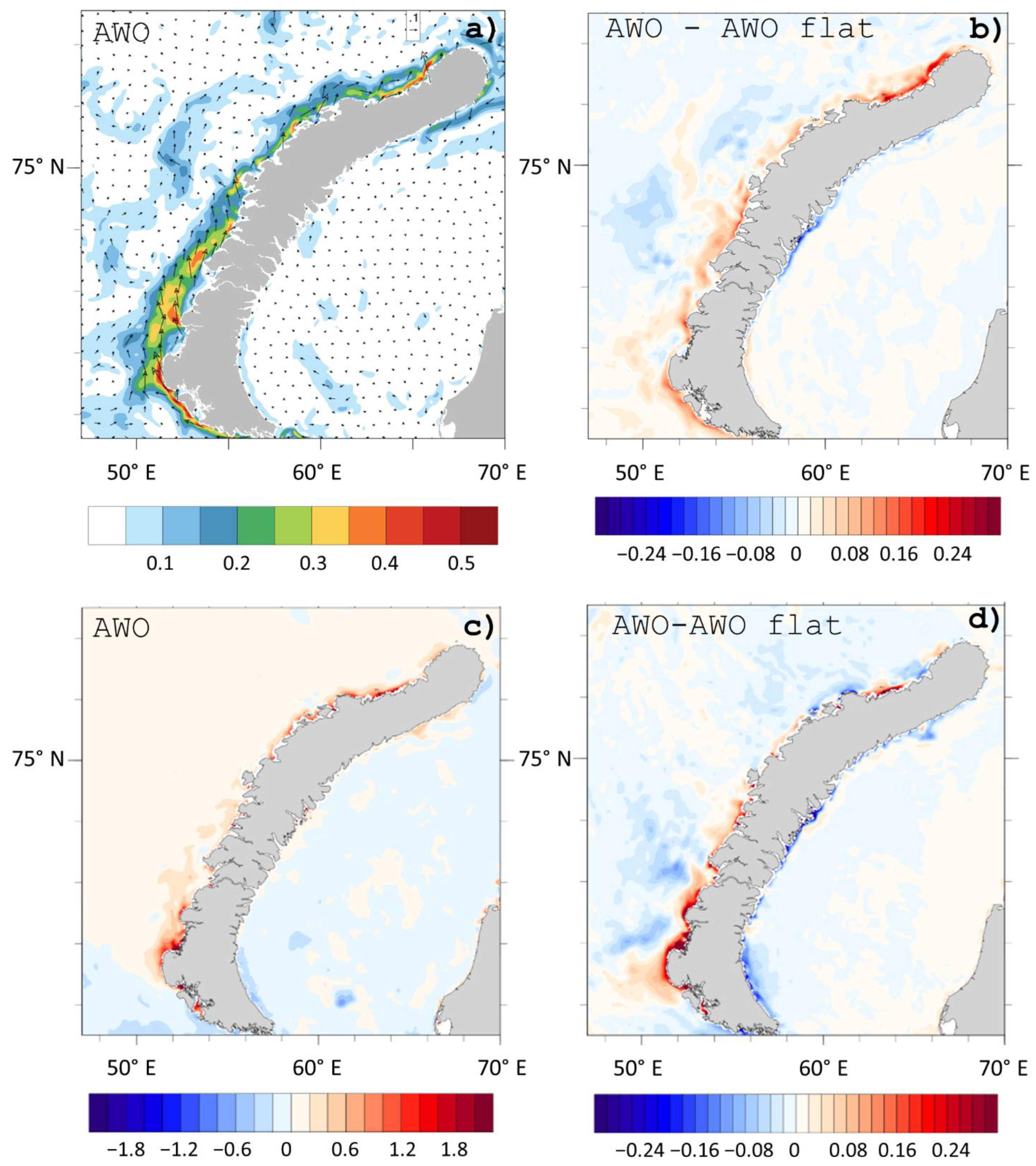
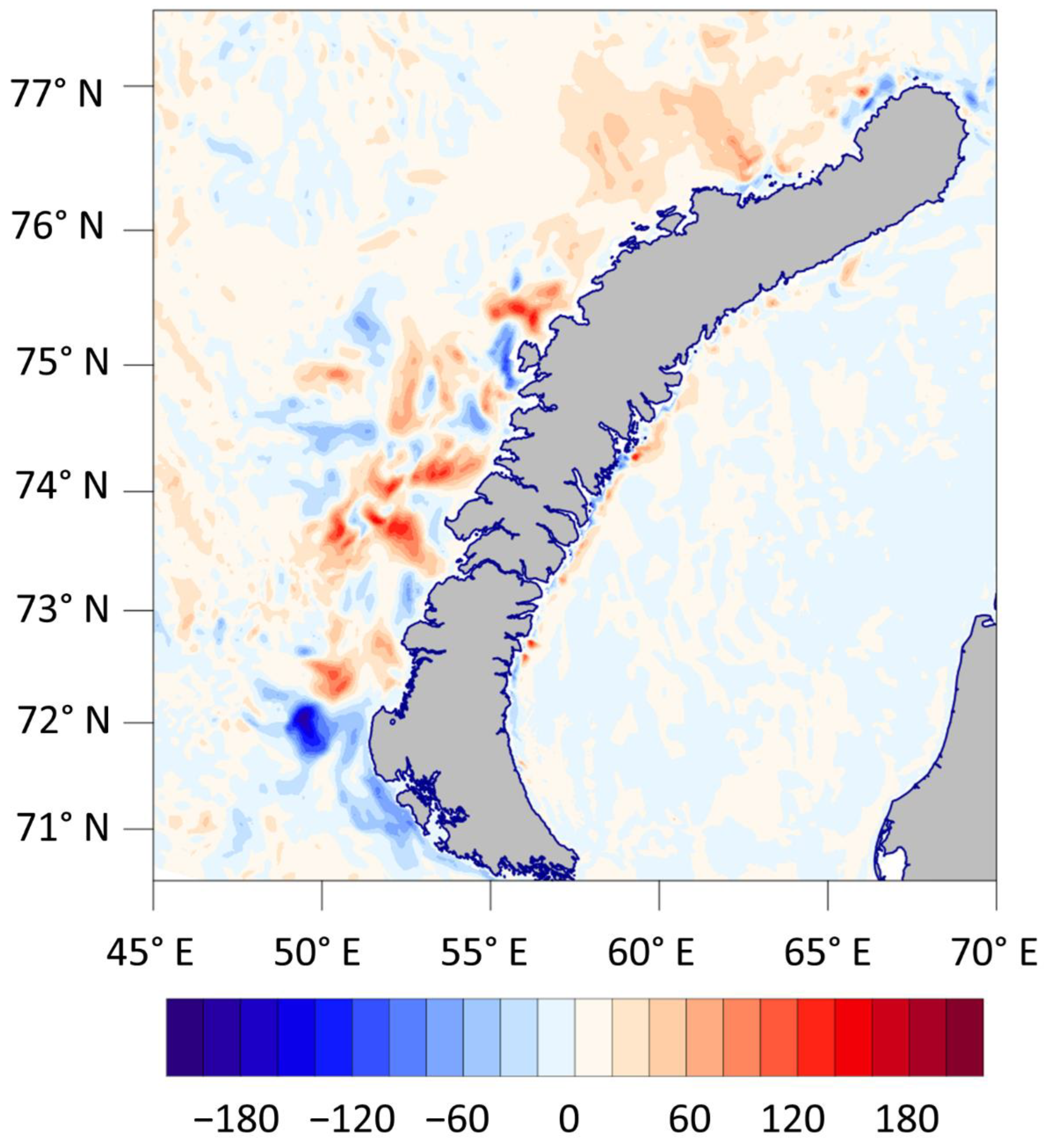
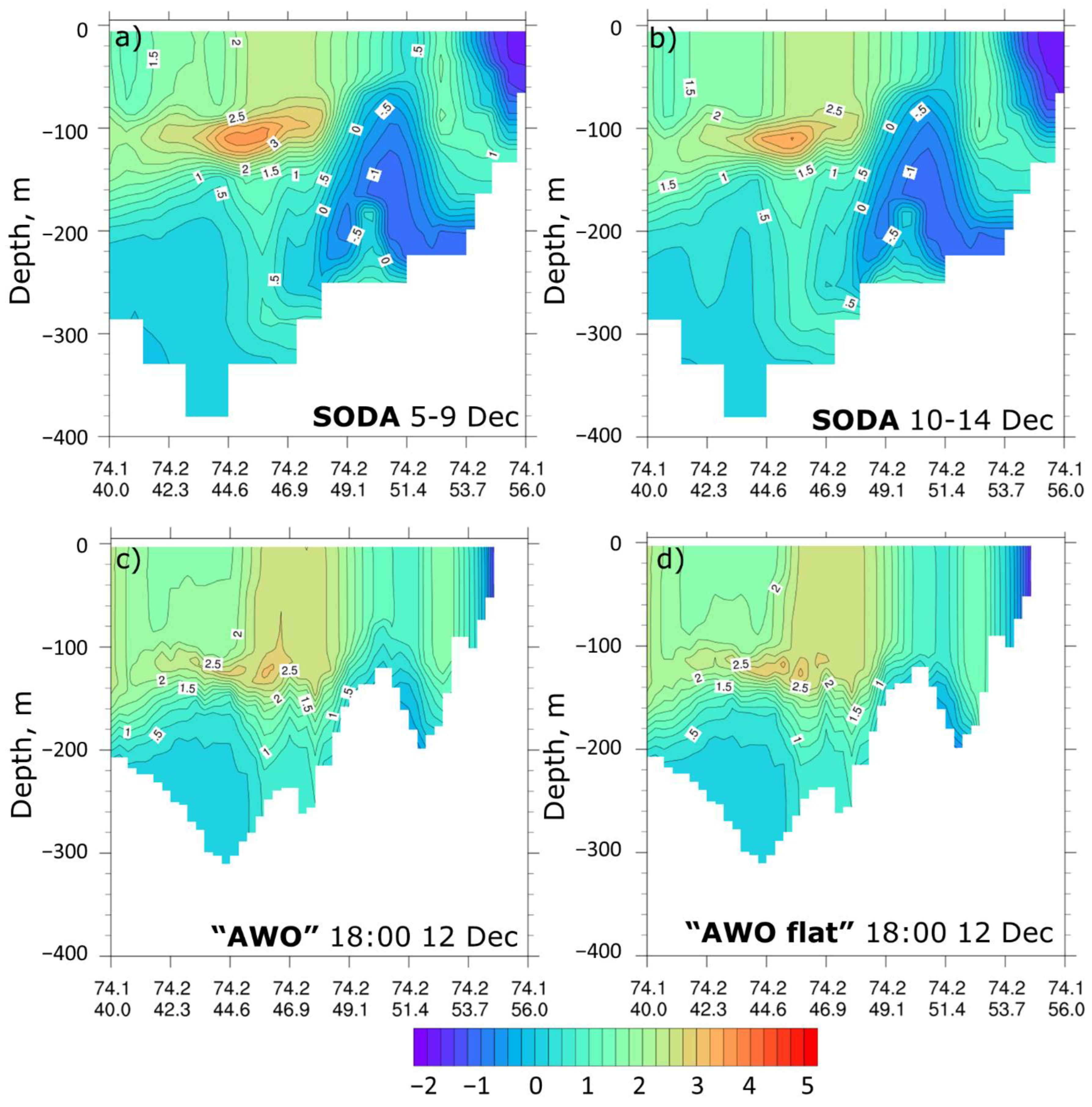
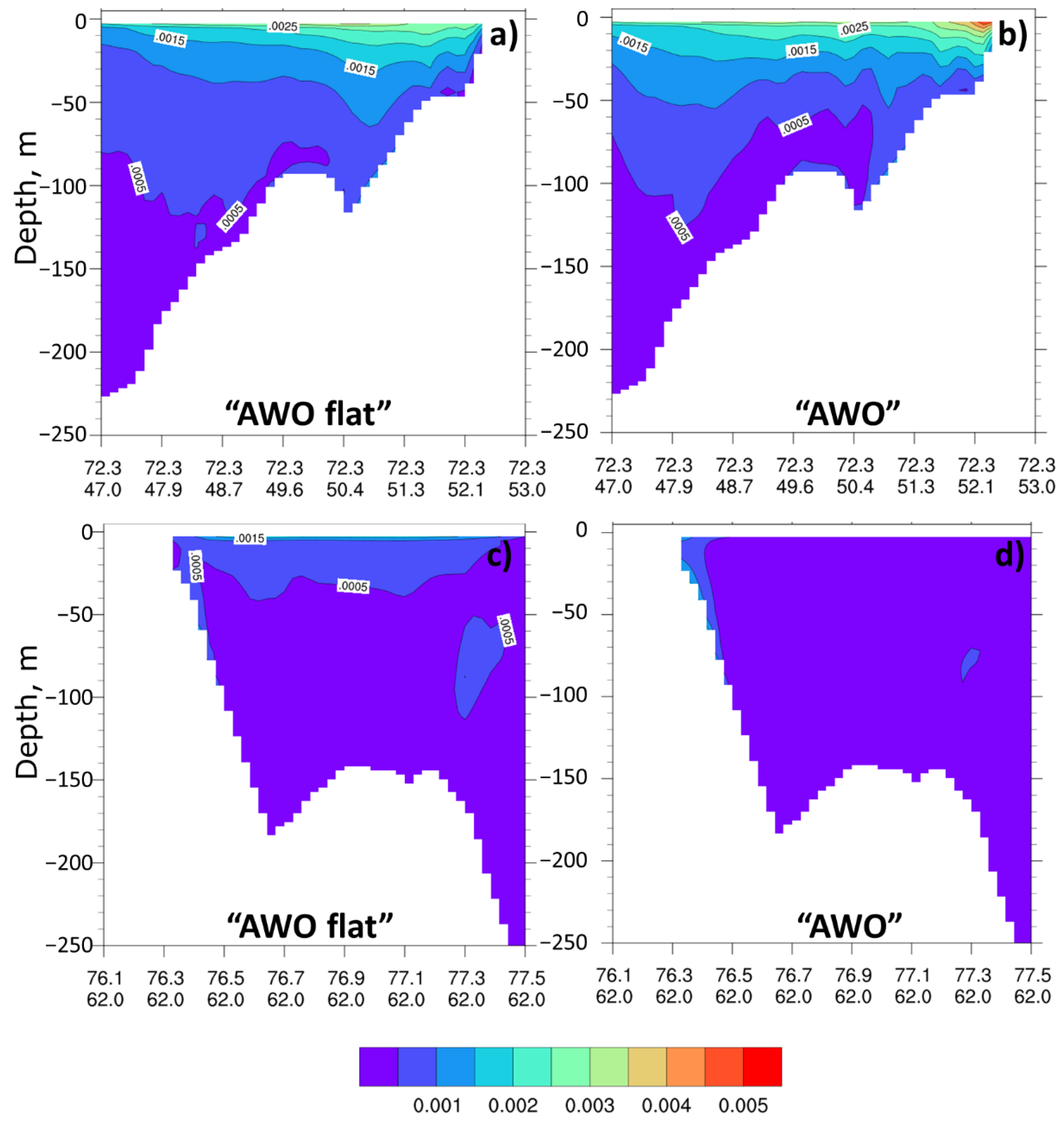
| WRF | ROMS | SWAN | Description | |
|---|---|---|---|---|
| “A” | + | − | − | Stand-alone WRF run |
| “AO” | + | + | − | Atmosphere-ocean coupling |
| “AW” | + | − | + | “Komen” formulation of wave growth by the wind, “Drennan” roughness length parametrization |
| “AWO” | + | + | + | Full coupling |
| “AWO Janssen” | + | + | + | As “AWO”, but “Janssen” formulation of wave growth by the wind |
| “AWO Taylor_ Yelland” | + | + | + | As “AWO”, but “Taylor_Yelland” roughness length parametrization |
| “AWO Oost” | + | + | + | As “AWO”, but “Oost” roughness length parametrization |
| “AWO flat” | + | + | + | As “AWO”, but flat topography |
| Bias | MAE | RMSE | R | |
|---|---|---|---|---|
| “A” | −1 | 1.6 | 2.1 | 0.81 |
| “AO” | −1 | 1.6 | 2 | 0.82 |
| “AW” | −0.5 | 1.4 | 1.8 | 0.82 |
| “AWO” | −0.6 | 1.4 | 1.8 | 0.83 |
| “Janssen” | −0.5 | 1.4 | 1.8 | 0.82 |
| “Taylor_Yelland” | −0.8 | 1.6 | 2 | 0.8 |
| “Oost” | −0.9 | 1.6 | 2 | 0.8 |
| Bias | MAE | RMSE | R | |
|---|---|---|---|---|
| “AW” | −0.47 | 0.58 | 0.7 | 0.77 |
| “AWO” | −0.5 | 0.6 | 0.72 | 0.77 |
| “Janssen” | −0.52 | 0.61 | 0.73 | 0.77 |
| “Taylor_Yelland” | −0.62 | 0.68 | 0.81 | 0.76 |
| “Oost” | −0.76 | 0.8 | 0.94 | 0.74 |
| H | LE | H + LE | τ | U10 | |
|---|---|---|---|---|---|
| “AO”–“A” | 1 (0%) | 1 (1%) | 1 (0%) | 0.00 (0%) | 0 (0%) |
| “AW”–“A” | 2 (2%) | 4 (4%) | 6 (2%) | −0.01 (−4%) | 0.4 (3%) |
| “AWO”–“A” | 3 (2%) | 4 (4%) | 7 (3%) | −0.01 (−4%) | 0.3 (3%) |
| “Janssen”–“A” | 3 (2%) | 5 (4%) | 8 (3%) | −0.01 (−3%) | 0.3 (3%) |
| “Taylor_Yelland”–“A” | 5 (3%) | 4 (4%) | 9 (3%) | 0.00 (1%) | 0.0 (0%) |
| “Oost”–“A” | 8 (5%) | 8 (8%) | 16 (6%) | 0.02 (7%) | −0.4 (−3%) |
| “AWO”–“AWO_flat” | −27 (−28%) | 0 (0%) | −28 (−18%) | 0.02 (7%) | 0.2 (2%) |
| “AO” | “AWO” | “Janssen” | “Taylor Yelland” | “Oost” | “AWO Flat” | |
|---|---|---|---|---|---|---|
| ΔOHC OHC1 = 2063 MJ/m2 | −55 (−2.7%) | −56 (−2.7%) | −56 (−2.7%) | −56 (−2.7%) | −56 (−2.7%) | −68 (3.3%) |
Publisher’s Note: MDPI stays neutral with regard to jurisdictional claims in published maps and institutional affiliations. |
© 2022 by the authors. Licensee MDPI, Basel, Switzerland. This article is an open access article distributed under the terms and conditions of the Creative Commons Attribution (CC BY) license (https://creativecommons.org/licenses/by/4.0/).
Share and Cite
Shestakova, A.A.; Debolskiy, A.V. Impact of the Novaya Zemlya Bora on the Ocean-Atmosphere Heat Exchange and Ocean Circulation: A Case-Study with the Coupled Model. Atmosphere 2022, 13, 1108. https://doi.org/10.3390/atmos13071108
Shestakova AA, Debolskiy AV. Impact of the Novaya Zemlya Bora on the Ocean-Atmosphere Heat Exchange and Ocean Circulation: A Case-Study with the Coupled Model. Atmosphere. 2022; 13(7):1108. https://doi.org/10.3390/atmos13071108
Chicago/Turabian StyleShestakova, Anna A., and Andrey V. Debolskiy. 2022. "Impact of the Novaya Zemlya Bora on the Ocean-Atmosphere Heat Exchange and Ocean Circulation: A Case-Study with the Coupled Model" Atmosphere 13, no. 7: 1108. https://doi.org/10.3390/atmos13071108
APA StyleShestakova, A. A., & Debolskiy, A. V. (2022). Impact of the Novaya Zemlya Bora on the Ocean-Atmosphere Heat Exchange and Ocean Circulation: A Case-Study with the Coupled Model. Atmosphere, 13(7), 1108. https://doi.org/10.3390/atmos13071108






